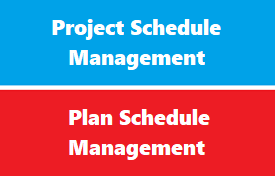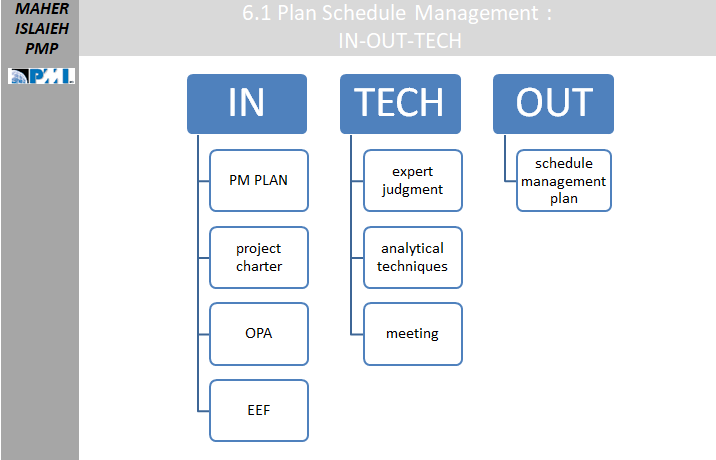introduction
Schedule Management Plan requires thinking proactively before executing the project. It involves thinking through several points, including But NOT Limited to :
- Individuals involved in the scheduling process
- The approach required to plan a schedule of the process
- Use of organizational processes and procedures
- Tools used for scheduling
- Method to manage and control the project to schedule baseline and manage any deviations
questions that Schedule plan answer
Schedule management plan answer questions like :
- Who will be involved in planning schedule
- What a broach we will use to plan schedule
- What processes and procedure (which are part of OPA) we will use to create schedule
- Does company has project management software to create schedule
- How we will manage and control schedule
- How will the schedule be developed?
- How aggressive will it be?
- Who will be notified?
- When and how will the schedule performance be measured?
- When the project is behind schedule, what actions will be taken to align it?
consideration when create schedule plan
- padding is extra time or cost added to estimate because estimator doesn’t have enough information, >> which is NOT allowed 🙁
- if estimator doesn’t have enough information , then project manager just to add time or cost to reserve through risk management
- Schedule management plan is deferent of schedule baseline
- Some project manager combine creating work package (deliverables )which is defined in process develop WBS with define activity list (work to perform deliverables ) which is defined in process define activities
- The schedule management plan is created as a part of Develop Management Plan process in Integration Management.
- A project manager must create a schedule management plan and it is observed that in real-world scenarios most of the project managers miss on this important aspect.
- A schedule management plan should include the methodology used to create the schedule.
- The project manager should also describe the use of scheduling software.
- He should identify the measurement guidelines i.e. should he measure the process progress in hours, days, weeks, months or quarters.
- The schedule management plan should also include the duration of each activity and the efforts required for those activities.
- This baseline is to be used to monitor and control the project during various phases.
- The project manager should also include a plan to mitigate any variances observed in the schedule.
Plan Schedule Management: Inputs
Project Charter
The project charter contains many elements, including any high-level constraints on the major constraints of scope, schedule, and cost.
In the case of the schedule, the sponsor of the project, who is responsible for the creation of the project charter, can specify any important milestone dates for the project in the “summary milestone schedule.”
This outlines the major constraints on the schedule, including the most important one, the projected deadline date for the completion of the project.
Project Management Plan
the project management plan consists of the following categories of elements:
- Management plans from each of the knowledge areas
- Three subsidiary management plans (requirements related to the scope knowledge area, and change and configuration related to the integration management process 4.6 Integrated Change Control)
- Project baselines–for scope, schedule, cost, and performance measurement (which uses earned value analysis that measures each of these constraints)
- Project life cycle (will the project be done in phases?) and product developmental approach
- Project documents (requirements documentation, issue log, change log, risk register, etc.)
Here are the elements that are used in creating the Schedule Management Plan.
- Scope Management Plan–the scope management plan shows how to go from the detailed Work Breakdown Structure created in the process 5.3 Define Scope to the first process used in creating the schedule, process 6.2 Define Activities. The WBS by itself just shows a list of work to be done; the planning processes of schedule management give a plan on exactly how to get that work done. It’s analogous to a recipe; you need both the list of ingredients (analogous to the WBS) and the instructions on how to turn those ingredients into the finished dish (analogous to the schedule).
- Product developmental approach (predictive, also known as traditional or waterfall, iterative/incremental, adaptive, also known as agile, and/or a hybrid approach)–this will have an effect on how the schedule is estimated, developed, and then controlled.
Enterprise Environmental Factors EEF
- Guidelines for tailoring the organization’s standard set of processes and procedures to a specific project
- Standardized estimating data for the application area and/or industry
- Scheduling software (crucial point: the software itself, such as Microsoft Project or Primavera, is an Enterprise Environmental Factor, but the data files themselves from previous projects are considered Organizational Process Assets)
- Organizational culture and structure–will determine how resources are allocated and decisions are made with respect to the schedule
- is it functional/centralized, devoted mainly towards operations, in which case decision making is done by a functional manager
- is it projectized, devoted mainly towards projects, in which case decision making is done by the project manager
- or a matrix organization, somewhere in between the two structures mentioned above, in which case decision making may be shared between the functional and project manager
- Availability of team member resources and physical resources within the organization
Organizational Process Assets OPA
- Policies, procedures and guidelines (whether formal or informal) related to the development, management, and control of the schedule
- Templates, forms, and monitoring and reporting tools
- Historical information and lessons learned repositories from previous similar projects
Plan Schedule Management: Tools and Techniques
Expert Judgment
Expertise should be considered from individuals who have expertise in the area of schedule development for your specific industry, including using scheduling software (like Microsoft Project or Primavera), or who had experience creating a schedule for a previous, similar project.
Data Analysis
The main data analysis technique used in creating a schedule management plan (not creating the schedule itself, mind you, but creating the plan) is alternatives analysis. The alternatives that may be determined, if they are not already set out in the schedule development, management and control-related policies for your organization (these would be included as part of the Organizational Process Assets, one of the inputs to this process), would include the following:
- does the entire schedule need to be done up front first? If it needs to be done in detail, then this follows a predictive, aka traditional or waterfall methodology.
- if the schedule needs to be done up front, but it can developed in stages or increments, then this follows an iterative or incremental model.
- if the entire schedule does not need to be done in detail, so that the work to be accomplished in the near term is planned in detail, but the work to be done in the future is planned at a higher level of detail, then this is following a rolling wave methodology. The analogy I use to describe this is that it is like laying down the train tracks for the farther portion of the railroad while the train has already started down the tracks.
- an agile or adaptive methodology is one where the project is completed in a series of stages called releases, which release features to the customer on an incremental basis.
Meetings
Meetings are where the planning is done to develop the Schedule Management Plan. Those that may be included are:
- the project sponsor
- the project manager
- selected project team members, especially those with responsibility for scheduling planning or execution,
- selected stakeholders, especially those with information on the basic constraints on the schedule (i.e., those that can suggest milestone dates)
- others as needed, particularly those project managers/project team members from previous projects that are similar to the project being planning
Schedule Management Plan components
Schedule Management Plan include the following BUT NOT limited to :
- project schedule model development
- level of accuracy
- unit of measure: hour day week
- organizational procedure link
- project schedule model maintenance
- control threshold
- rules of performance measurement like EVM
- reporting format
- process description


